

Mexican American Proarchive: Annual Report on Mexican American Professionals
News from the census American Community Survey is generally good for the 2015 year. Mexican American college enrollment was up from 18.7% to 18.9% in the 2014 and 2015 years. Graduate or professional degree attainment was also up from 2.9% to 3.0%. The number of bachelor’s degrees granted to Mexican American students rose from 7.6% in 2014 to 7.8% in 2015.


In spite of these gains, Mexican Americans still remain at the bottom of the ladder when it comes to earning a bachelor’s degree. Even after broadening the group to Latinos or Hispanics, this group still lags behind. According to the Pew Hispanic Center: “As of 2014, among Hispanics ages 25 to 29, just 15% of Hispanics have a bachelor’s degree or higher. By comparison, among the same age group, about 41% of whites have a bachelor’s degree or higher (as do 22% of blacks and 63% of Asians).” Pew reports that the main reasons for this low graduation rate is that Hispanics are less likely “to enroll in a four-year college, attend an academically selective college and enroll full-time.”
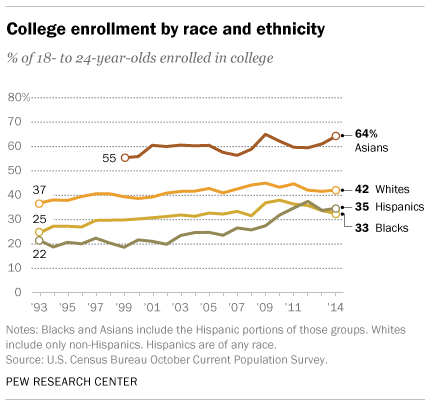
Also in the good news column, the University of California will continue to push for a greater number of underrepresented minorities; namely, Chicano/Latino students whose resident freshmen numbers rose from 2.7% to 32.3% of admitted California freshmen. In other good news, the proportion of Chicano/Latino students transferring from community colleges increased to 29.3% from 26.8% for 2015.
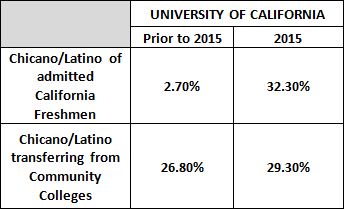
Occupations, including those in management, business, science, and art, fared better for Mexican Americans. The number of Mexican Americans filling these occupations rose from 17.4% in 2014 to 17.5% in 2015.

The total number of Hispanics filling these occupations was 16.1% in 2015, a bit lower than Mexican Americans specifically.
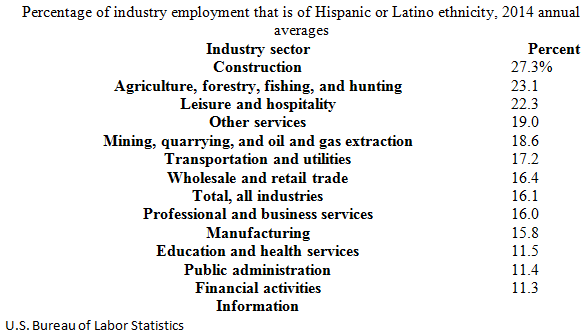
The report shows that industrial employment for Mexican Americans remained the same for 2014 and 2015 at 10.2%.
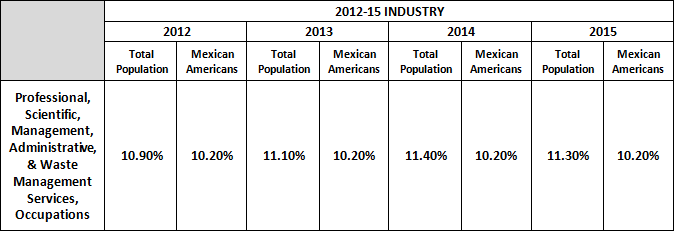
The figures for Hispanic or Latino employment for 2015 and 2016 show a healthy increase.
According to the Pew Hispanic center, “Construction, professional and business services, health services, financial services and food services…showed healthy gains.” Most of the jobs gained by native-born Hispanic workers were in manufacturing, mostly durable goods (82,000 Hispanic workers in this industry), followed by wholesale and retail trade (79,000), publishing, broadcasting, communication and information services (55,000), and construction (54,000).
Foreign-born Hispanics had the most job gains in construction (417,000), followed by business and professional services (179,000). Together, those two industries accounted for almost three-quarters (74%) of all jobs gained by foreign-born Latinos between 2005 and 2006.
The business and professional services sector, which ranges from management and technical services to janitorial, landscaping, and waste management services, is also a key employer for non-Hispanic workers. Of the total increase in employment in 2005-06, non-Hispanic workers accounted for 410,000 employees in the industry, native-born workers 327,000, and foreign-born workers 83,000.
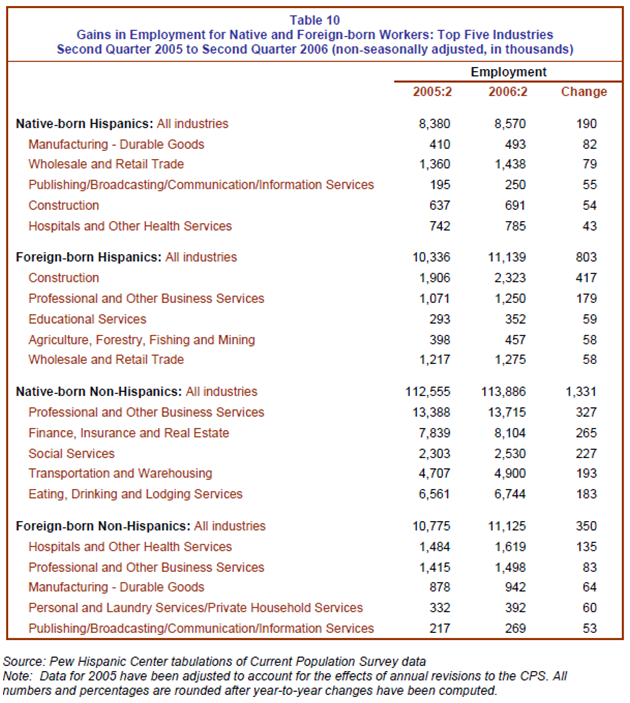
Sources
- Census Bureau, Selected Population Profile in the United States: 2015
- Pew Research Center
- University of California
- Bureau of Labor Statistics
Event speaker says Texas’ Hispanic community is an economic powerhouse that will only continue to grow
The Hispanic community is a growing part of the economic engine of Texas, marketing pro Terry Soto said at the annual Hispanic Business Achievers luncheon on Wednesday.
“To market to our community, thinking about a market that used to exist 10 or 20 years ago doesn’t work,” Ms. Soto explained. “We have to evolve our thinking and our approach to this community.”
Ms. Soto, president and CEO of About Marketing, has worked with Fortune 500 organizations including Walgreen’s, ALDI Supermarkets, Verizon Wireless Coca Cola, Citibank, Kraft Foods and Disney, among others. She told a capacity crowd at Harvey Convention Center that the Hispanic community will continue to grow as an economic and demographic force in Tyler and the rest of the nation…
Link to article
English graduate student wins Ford Foundation Dissertation Fellowship
Cesar Soto wants to know how the spark of political revolution can transform religious concepts of community and inclusion.
To better understand the issue, he’s turning to the literature of England, Ireland, and Mexico in the late 1700s and early 1800s.César Soto wants to know how the spark of political revolution can transform religious concepts of community and inclusion.
Soto, a Ph.D. candidate in Notre Dame’s Department of English, has been awarded a Ford Foundation Dissertation Fellowship for 2016-17 to support his project.
The fellowships recognize graduate students who have demonstrated superior academic achievement, show promise as future scholars and teachers at a college or university level, and are prepared to use diversity as a resource to enrich the education of all students…
Link to article
A community in need: Rate of Latino physicians shrinks, even as Latino population swells
By Almendra Carpizo
Record Staff Writer
Celida Lizarraga doesn’t remember seeing many doctors who looked like her when she had to translate for her parents during medical visits.
The 17-year-old said most doctors didn’t speak Spanish and an official interpreter wasn’t always available. And even when interpreters were there, she said, there was disconnect between her parents and the doctor.
“I was the one who my parents relied on,” Lizarraga said.
The group Latino Physicians of California is emphasizing the need for more Latino physicians in the state, where about 40 percent of the population is Latino, but less than 5 percent of doctors are Latino.
During a media phone conference on Friday,…
Link to article
Obama White House Touts Latino Gains in Income, Education, Health
by SUZANNE GAMBOA
WASHINGTON, DC — The White House on Wednesday touted gains Hispanics have made in education, income and health insurance during President Barack Obama’s time in office.
In a report released to mark the closing days of Hispanic Heritage Month, which ends Saturday, the White House issued a four-page brief from its Council on Economic Advisers on the Hispanics’ economic progress in the Obama years.
Obama marked the close of Hispanic Heritage month with remarks at a White House reception Wednesday afternoon. Hispanic Heritage Month began Sept. 15 and closes on Saturday.
“Over the last eight years we have made a lot of progress, together for all Americans and nowhere have you been able to see more vividly the progress than in the Hispanic American community,” Obama said at the event…
Link to article
USC professor spotlights the significance of Latinos to California’s future
The USC Price School of Public Policy has taken a leading role in training local decision-makers and its partnership with the Latino Caucus demonstrates the inroads it has made.
That’s a thought from USC Price Professor Raphael Bostic.
USC Price hosted more than 20 public officials from the League of California Cities Latino Caucus, who took part in the Bedrosian Center on Governance’s Local Leaders Executive Education Forum on Sept. 22 and 23.
The participants, many of whom are mayors or council members of cities across California, heard presentations from USC Price faculty on leadership, public ethics and housing policy, among other topics.
Professor Frank Zerunyan, director of executive education at the Bedrosian Center, led the program, which was the product of an agreement that USC Price and the Bedrosian Center signed with the Latino Caucus in 2014 to provide training aimed at enhancing the leadership capacity of public officials statewide…
Link to article
Daniel Torres Hispanic Center urges young Latinos to vote
Kyle Edelman
The presidential election is straight out of a soap opera: Twitter fights, mudslinging and personal attacks are flying between the front-runners. It does make for some great drama. Although the United States is predominantly white, 31 percent of eligible voters in the 2016 election are minorities, according to pewresearch.org…
Link to article
Statistical Portrait of Hispanics in the United States
There were 55.3 million Hispanics in the United States in 2014, comprising 17.3% of the total U.S. population. In 1980, with a population of 14.8 million, Hispanics made up just 6.5% of the total U.S. population. Read the accompanying report, “The Nation’s Latino Population Is Defined by Its Youth.”…
Link to article
Raciolinguistics” How Language Shapes our Ideas about Race
AF Ball – 2016
… Gordon, University of Arizona 3. From Mock Spanish to Inverted Spanglish: Language Ideologies
and the Racialization of Mexican and Puerto … University of South Carolina 5.“Suddenly Faced
with a Chinese Village”: The Linguistic Racialization of Asian Americans 97 adrienne …
Link to book preview
4 Academic Agency in Ya Novels by Mexican American Women Authors
V Canales – Gender (ed) Identities: Critical Readings of Gender …, 2016 – books.google.com
The theme of academic achievement intention in contemporary young adult literature (YAL)
by Mexican American women authors demonstrates seizing power previously denied to
Mexican American youth and adolescents. A century ago, children of Mexican origin in the …
Link to book preview
NMSU observes National Hispanic-Serving Institution Week, Elba Serrano to speak
LAS CRUCES — New Mexico State University joins the nation in celebrating National Hispanic-Serving Institution Week Sept. 12-18.
NMSU Regents Professor Elba Serrano is the keynote speaker Sept. 14 at 4 p.m. at Domenici Hall in the Yates Theater. Serrano will talk about the importance of NMSU’s HSI designation and how it positively impacts research funding. The event is open to the public…
Link to article
Annual New Mexico Hispanic Fiesta Draws Native American Ire
It’s a week-long event that draws together generations of northern New Mexico Hispanic residents, some who can trace their roots to the 1600s.
For centuries, northern New Mexico Hispanic residents have held an elaborate festival in Santa Fe to honor Spanish conquistador Don Diego De Vargas, who reclaimed the city following an American Indian revolt. There is music, dancing, a parade and the reenactment of De Vargas’s “peaceful reoccupation” of what is now New Mexico’s capital…
Link to article
Center for Mexican-American studies welcomes new director
The College of Liberal Arts’ UT Center for Mexican American Studies has selected professor John Morán González as its new director.
González previously had a courtesy appointment with the Department of Mexican American and Latina/o Studies. He teaches courses in Latina/o cultural studies, Mexican American literature and late 19th-century U.S. literature. He has published in journals such as American Literature, Aztlán and Nineteenth-Century Contexts. González also edited The Cambridge Companion to Latina/o American Literature, published in 2016. This publication is the first critical reference anthology devoted to Latin literature…
Link to article
4 Academic Agency in Ya Novels by Mexican American Women Authors
V Canales – Gender (ed) Identities: Critical Readings of Gender …, 2016 – books.google.com
The theme of academic achievement intention in contemporary young adult literature (YAL)
by Mexican American women authors demonstrates seizing power previously denied to
Mexican American youth and adolescents. A century ago, children of Mexican origin in the …
Link to article
Nationally Recognized Scholar of Latino Politics to Speak at CSU, Chico for Constitution Day 2016
Dr. Gary Segura of Stanford University will make the California State University, Chico Constitution Day keynote address, “The Future is Ours: How Demographic Change and Latino Voters Are Changing American Politics in 2016 and Beyond.” The event is on Tuesday, September 20 at 6 p.m. in the Bell Memorial Union auditorium. It is a free, public event open to all students, faculty and community members.
Gary Segura is the Morris M. Doyle Centennial Professor of Public Policy at Stanford University. He is the director of the Stanford Institute on the Politics of Inequality, Race and Ethnicity, and a fellow of the American Academy of Arts and Sciences. His work focuses on issues of political representation and social cleavages, the domestic politics of wartime public opinion, and the politics of America’s growing Latino population…
Link to article
California school test scores: Amid gains in English and math, ethnic gap widens
California students’ scores in English and math rose from last year to this spring, with gains spanning gender, race, language and socioeconomic differences, test results released Wednesday show.
However, the encouraging news in the annual state test scores was tempered by a harsh reality: Overall, fewer than half of students statewide — 49 percent in English and just 37 percent in math — scored proficient.
And alarmingly, the wide gap in performance between Asian and white students on one hand and black and Latino students on the other remains unrelenting, despite years of focused efforts and a recent infusion of state funds to close it…
Link to article
Retooling the Ph.D.
For generations, the path of a doctoral candidate in the humanities has been clear: collect your sheepskin and go directly to academia. But a tight job market for those graduates is leading universities across the country to rethink that model. Now, a grant from the National Endowment for the Humanities (NEH) will help UC Santa Barbara explore ways to create new post-doctorate options for its humanities students…
Link to article
‘I’m Latino and I Don’t Speak Spanish’: Young Men Talk About Identity
Am I Hispanic enough? Am I American enough? This is the dilemma that many Latinos face at some point in their lives, whether they are 1st or 5th generation.
Part of this is the tension in answering people’s assumptions, expectations and yes, stereotypes that exist about what “constitutes” a Hispanic. And these assumptions come from both inside and outside the Latino community.
We spoke to three young men who have different upbringings and unique backgrounds. Yet they have one trait in common: their love for their roots, and their candor at some of the challenges they have while trying to explain their cultural identities…
Link to article
Young Latina Poet’s Ode to Her Heritage Goes Viral
Xochitl Morales may be young, but she learned early to use her voice to highlight her community and culture. Through poetry, the sixteen year old demonstrates what it means to be a Mexican American. Her video poem, titled “Latino-Americanos: The Children of An Oscuro Pasado” addresses her cultural identity.
The video went viral and has been shared widely on Facebook and other social media, as well as by Latino sites. The poem is a response to Donald Trump’s comments about Mexicans in the U.S. “My culture is important, although it wasn’t always accepted. This poem is a call to action, it a reminder to never forget where you come from” Morales said…
Link to article
Sarah Robles Wins The First U.S. Weightlifting Medal since 2000
RIO DE JANEIRO – Less than 10 seconds separated Sarah Robles from a personal goal and a historic performance. That was her coach’s message to her heading into her final lift on Sunday at Riocentro – Pavilion 2.
“I said to her, ‘Do you want to be on the medal stand? This is your opportunity,’” said Tim Swords, Robles’ coach. “’This is five seconds against the rest of your life.’ I said, ‘What do you want to do?’ You gotta bring it now, and you gotta go for it. Just five seconds of your life. This is going to change your life. Five seconds.’”
A lift of 160 kg. after five grueling lifts, each one heavier than the last, gave Robles her first Olympic medal, a bronze in the +75 kg. weight class. It was Team’s USA first medal in women’s weightlifting in 16 years.
Robles lifted a combined 286 kg., including 126 kg. in the snatch and 160 kg. in the clean and jerk. She finished 21 kg. behind China’s Suping Meng, who took home the gold medal…
Link to article


